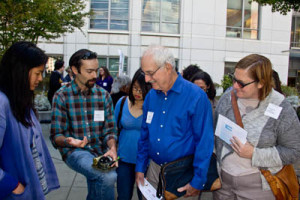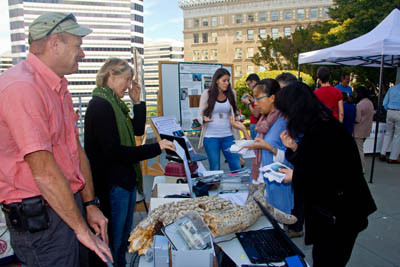NRS Fair marks 50th anniversary

Año Nuevo Island Reserve director Patrick Robinson shows off one of the satellite tags he and his colleagues use to track the migrations of northern elephant seals. Image credit: Lobsang Wangdu
The Natural Reserve System brought a taste of the science, art, teaching and natural wonders of its 39 reserves to the heart of downtown Oakland on Tuesday, August 11, for the NRS Fair. Hundreds of visitors flocked to the Franklin fifth-floor terrace. They chatted with graduate student researchers, marveled at animal skulls, held a woodpecker granary and gained a new appreciation for the value of the reserve system.
“It was like walking through an episode of NOVA,” said Deborah McCaskey of the President’s Executive Office, marveling at the scientific variety and significance of the work on display.
Music, science, art, fun
Booths from reserves bristling with exhibits ringed the perimeter of the terrace, alongside graduate students eager to talk about their thesis research, which was depicted on posters. Adding to the festive air was the chance to enter a drawing for a two-night trip to Hastings Natural History Reservation, plus the tantalizing smells of the paella station, gelato for dessert and background music courtesy of DJ Renoir.
The fair was part of a yearlong celebration of the system’s 50th anniversary. NRS Operations Manager Thembi Jackson organized the hit event.

Acorn woodpecker granaries and oak research drew lots of visitors to the Hastings Natural History Reservation table, where director Vince Voegeli (left) and his wife, Sandy, answered questions. Image credit: Lobsang Wangdu
NRSers from across the state showcased highlights from their reserves. The contingent from UC Santa Barbara’s seven reserves, which included NRSers Sue Swarbrick, Don Canestro of Norris Rancho Marino Reserve and Gay Larsen, brought the massive skull of an elephant seal bull as well as a badger stuffed in the “flying Superman” pose customary for museum specimens.
From ecoinformatics to acorn woodpeckers
The Berkeley NRS was out in force. Vince Voegeli and family from Hastings Natural History Reservation talked about deer mouse, oak and avian research happening at the reserve, and let people examine a section of tree trunk perforated by acorn-stashing woodpeckers. Blue Oak Ranch Reserve’s Michael Hamilton and Erik Viik demonstrated their microclimate sensor network and ran animations of the new visitor facilities now being built at the reserve.
Michelle Koo and Heather Constable of Berkeley’s Museum of Vertebrate Zoology showed off the HOLOS EcoInformatics Engine. This web-based system enables scientists to plot thousands of plant and animal specimens in museums on maps featuring vegetation, climate, soil and other data. The engine offers a powerful new tool for those seeking to study the effects of climate and other environmental conditions on the distribution of species.
Climate, oceans and Earth’s support system
Representing the NRS’s ISEECI climate change initiative, Laurel Fox and Becca Fenwick of UC Santa Cruz described the reserve system as an ideal window to study the impacts of climate change on animals, plants and entire ecosystems. This research received a $1.9 million UC President’s Catalyst Award in January.
Lewis Reed, of UC Davis’s Bodega Marine Reserve, laid out delicate fans of dried marine algae along with a sea otter pelt to illustrate the reserve’s coastal resources. Another marine-focused reserve representative, Patrick Robinson of UC Santa Cruz’s Año Nuevo Island Reserve, demonstrated how elephant seal researchers glue satellite tags to the heads of their subjects to observe seal behaviors and get a window into ocean conditions.
Representing the creative arts, artist Stephanie Lie was on hand to display the art prints she is making as part of a project to photograph Kendall-Frost Mission Bay Marsh Reserve in San Diego.
Equally inspiring were the half-dozen graduate students who provided posters describing their reserve-based research. Topics ranged from the impact of a warming climate change on Sierra lakes, to ocean acidification effects on marine organisms, to the hunter-gatherer communities on Santa Cruz Island, to biocontaminant accumulation in elephant seals, to how environmental conditions affect water filtration by coastal marine communities.

Reserve steward Lewis Reed describes the research, education, and habitat restoration programs at Bodega Marine Reserve. Image credit: Lobsang Wangdu
Making the connection
For many UCOP staff, the event was a chance to see how their work affects the education of students and conservation of the environment. In an email later that afternoon Amal Smith, director of UC’s Business Resource Center, wrote, “I wished I had more time to hear about all the wonderful, exciting work that is taking place. I — and other BRC staff — really loved hearing about people’s ideas and passion, and loved the opportunity to link our BRC transactional work to the programs and research that your office manages and delivers.”
Overall, the event garnered rave reviews from attendees. “The whole party (exhibits, people who explained exhibits, delicious food, etc.) was a home run! I think lots of people learned a lot today about one of UC’s extraordinary institutions, the NRS,” emailed attorney Eric Behrens of UC’s Office of General Counsel.


